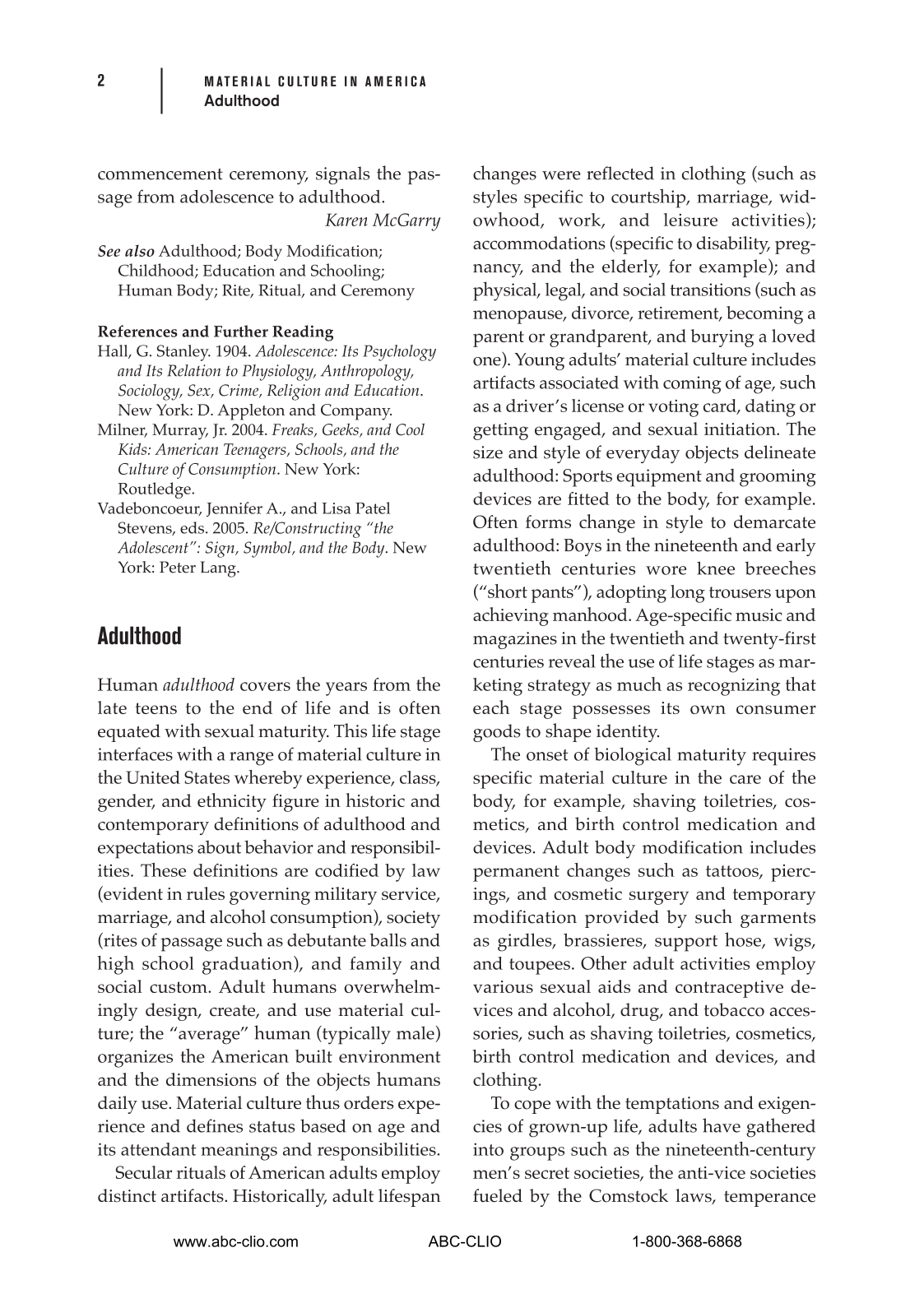www.abc-clio.com ABC-CLIO 1-800-368-6868
commencement ceremony, signals the pas-
sage from adolescence to adulthood.
Karen McGarry
See also Adulthood; Body Modification;
Childhood; Education and Schooling;
Human Body; Rite, Ritual, and Ceremony
References and Further Reading
Hall, G. Stanley. 1904. Adolescence: Its Psychology
and Its Relation to Physiology, Anthropology,
Sociology, Sex, Crime, Religion and Education.
New York: D. Appleton and Company.
Milner, Murray, Jr. 2004. Freaks, Geeks, and Cool
Kids: American Teenagers, Schools, and the
Culture of Consumption. New York:
Routledge.
Vadeboncoeur, Jennifer A., and Lisa Patel
Stevens, eds. 2005. Re/Constructing “the
Adolescent”: Sign, Symbol, and the Body. New
York: Peter Lang.
Adulthood
Human adulthood covers the years from the
late teens to the end of life and is often
equated with sexual maturity. This life stage
interfaces with a range of material culture in
the United States whereby experience, class,
gender, and ethnicity figure in historic and
contemporary definitions of adulthood and
expectations about behavior and responsibil-
ities. These definitions are codified by law
(evident in rules governing military service,
marriage, and alcohol consumption), society
(rites of passage such as debutante balls and
high school graduation), and family and
social custom. Adult humans overwhelm-
ingly design, create, and use material cul-
ture; the “average” human (typically male)
organizes the American built environment
and the dimensions of the objects humans
daily use. Material culture thus orders expe-
rience and defines status based on age and
its attendant meanings and responsibilities.
Secular rituals of American adults employ
distinct artifacts. Historically, adult lifespan
changes were reflected in clothing (such as
styles specific to courtship, marriage, wid-
owhood, work, and leisure activities);
accommodations (specific to disability, preg-
nancy, and the elderly, for example); and
physical, legal, and social transitions (such as
menopause, divorce, retirement, becoming a
parent or grandparent, and burying a loved
one). Young adults’ material culture includes
artifacts associated with coming of age, such
as a driver’s license or voting card, dating or
getting engaged, and sexual initiation. The
size and style of everyday objects delineate
adulthood: Sports equipment and grooming
devices are fitted to the body, for example.
Often forms change in style to demarcate
adulthood: Boys in the nineteenth and early
twentieth centuries wore knee breeches
(“short pants”), adopting long trousers upon
achieving manhood. Age-specific music and
magazines in the twentieth and twenty-first
centuries reveal the use of life stages as mar-
keting strategy as much as recognizing that
each stage possesses its own consumer
goods to shape identity.
The onset of biological maturity requires
specific material culture in the care of the
body, for example, shaving toiletries, cos-
metics, and birth control medication and
devices. Adult body modification includes
permanent changes such as tattoos, pierc-
ings, and cosmetic surgery and temporary
modification provided by such garments
as girdles, brassieres, support hose, wigs,
and toupees. Other adult activities employ
various sexual aids and contraceptive de -
vices and alcohol, drug, and tobacco acces-
sories, such as shaving toiletries, cosmetics,
birth control medication and devices, and
clothing.
To cope with the temptations and exigen-
cies of grown-up life, adults have gathered
into groups such as the nineteenth-century
men’s secret societies, the anti-vice societies
fueled by the Comstock laws, temperance
2
M AT E R I A L C U LT U R E I N A M E R I C A
Adulthood












































































































































































































































































































































































































































































































































































































